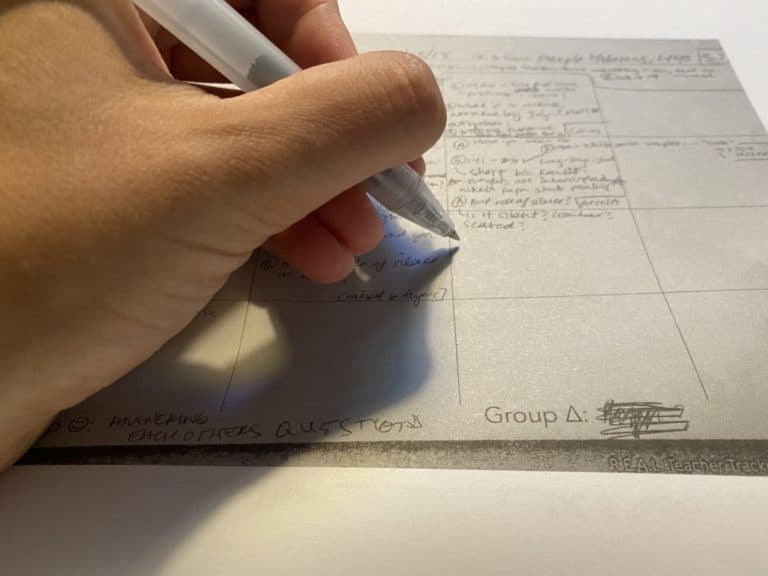Faculty Advisory Board Interview: R.E.A.L. Equips Department Chairs to Balance Faculty Autonomy and Alignment
Jim Moore is the English Department Chair at Blair Academy (NJ) and a Faculty Advisory Board member at R.E.A.L.® Discussion. We interviewed Jim about his approach to leadership and how R.E.A.L. supports him in balancing autonomy and alignment for his teachers. What follows is a conversation between Jim and R.E.A.L.® Partnerships and Program Manager Catherine Dragone. This conversation has been lightly edited for clarity.
Catherine: Jim, we are so glad to have you – you have been a visionary leader in the R.E.A.L.® program since the very beginning and mentored other R.E.A.L.® Program leaders along the way. Beyond grateful! To kick off this conversation, where did you grow up and where are you now?
Jim: I am from Rochester, New York, originally, but I’ve been at Blair Academy for 26 out of the last 35 years. I am currently the English Department Chair, but have worn many different hats.

Catherine: Thinking back to those Rochester days, can you describe yourself as a student in three words?
Jim: Interested, noncommittal, and engaged.
Catherine: Did you have a favorite teacher or teachers? And why?
Jim: I did. I had an English teacher named Alan Pavlik who challenged me to be engaged in the classroom—not just in discussion but in actively doing things. He is still alive and living in Hollywood now. Another teacher, Michael Lasser, taught me how to take an aggressive approach to analyzing literature rather than a passive, conversational one. Both of these teachers made a big difference for me, and I’ve communicated with both of them in the last two years.They were the right teachers at the right time for me.
Catherine: Thinking about your teaching and leadership now, how would you describe your academic leadership style?
Jim: I begin by recognizing the foundational tension between autonomy and alignment. People teach at a school like Blair because they want a certain level of autonomy. They don’t come here to be locked into a rigid curriculum. So, I try to protect that autonomy while also encouraging alignment in areas where it’s essential.
Discussion is a perfect example of threading that particular needle. Every veteran teacher at a school like ours thinks they’re already great at leading discussions. But how do they actually know? My sister, who is a management consultant, always asks her clients, “How do you know?” Ok, so the kids like your class because of the discussions? Well, that’s one piece of feedback, but it’s not actually an indicator of skill development. So the question is how do we know that our discussion methods are doing what we want them to do? We need a shared language and a system.
With R.E.A.L. Discussion, which has evolved into Blair Academy’s version of “Harkness” method, we can measure discussion. We can track involvement through Dialogic and observable behaviors. R.E.A.L. helps students learn to recognize discussion dynamics and step up to fill different roles — there’s always a student for example, who steps up as the “traffic cop” to manage the flow of conversation. That’s when I sit back and say to the kids, “You got this.”
When some teachers are resistant to the more structured aspects of R.E.A.L., I always remind them that I changed my own approach when I found a better way. So, when it comes to Academic Leadership, I focus on maintaining both alignment and autonomy— ensuring teachers still feel excited about their own lesson designs while also adhering to best practices like structured discussion.
Catherine: Those observations resonate deeply with patterns we have seen across many schools. Thank you for saying them ‘out loud!’ So, with all of that in mind, what are your hopes for students and teachers when it comes to discussion?
Jim: For teachers, in the age of AI, the heavy lifting has to happen in the classroom and off-screen. Homework should be formative — preparing students for the next class rather than just regurgitating information. This new premium on discussion means that teachers need to assess discussion in a meaningful way – not just on instinct or group grades. Department Chairs must manage this change and equip teachers with new tools for equitable assessment of discussion.
For students, I want R.E.A.L. to make discussion a welcome opportunity for those who usually fear speaking up in class. I have two brilliant students right now who were previously hesitant to speak up. R.E.A.L. gives them the structure and encouragement to contribute. At the same time, it teaches students who are like I was — the ones who always dominate discussions — to step back, listen, and share the floor.
For students, I want R.E.A.L. to make discussion a welcome opportunity for those who usually fear speaking up in class. I have two brilliant students right now who were previously hesitant to speak up. R.E.A.L. gives them the structure and encouragement to contribute. At the same time, it teaches students who are like I was — the ones who always dominate discussions — to step back, listen, and share the floor.
Jim moore
Catherine: Absolutely. R.E.A.L. supports both ends of the spectrum—giving some students the courage to speak while encouraging others to listen.
Jim: Exactly. It was really gratifying the other day when my advanced class, which I don’t explicitly train in R.E.A.L, naturally asked me, “Do we need a DQ Prep [the R.E.A.L. vocabulary describing preparation routines] sheet for this?” They had internalized the process in their ninth and tenth grade classes, and they held a thoughtful, structured 45-minute discussion with very little off-topic chatter. That’s when I knew the work was paying off.
Catherine: That’s fantastic. If you had to summarize the power of R.E.A.L. Discussion in three words, what would they be?
Jim: Three words to describe R.E.A.L.® Discussion? Civilizing, inclusive, and a way to recognize complexity. It is a structure that helps students reject oversimplified answers and make room for nuance.
Catherine: Those are great words. It’s almost like you are an English teacher! Ok, for someone who knows nothing about R.E.A.L. how would you explain it?
Jim: R.E.A.L.® Discussion is “Harkness” with training wheels for Gen-Z — a structured way for students to conduct thoughtful discussions on complex issues, and for teachers to effectively assess those discussions. It is both assignable and assessable.
R.E.A.L.® Discussion is “Harkness” with training wheels for Gen-Z — a structured way for students to conduct thoughtful discussions on complex issues, and for teachers to effectively assess those discussions. It is both assignable and assessable.
Jim Moore
Catherine: What a great metaphor! Thanks, Jim, for that punchy last line and for these wide-ranging reflections. For anyone wondering, the “Harkness” method Jim is referencing was originally developed at Phillips Exeter Academy and you can learn more about it here. Jim, thanks again – we appreciate your leadership and appetite for real discussion about academic leadership. .






